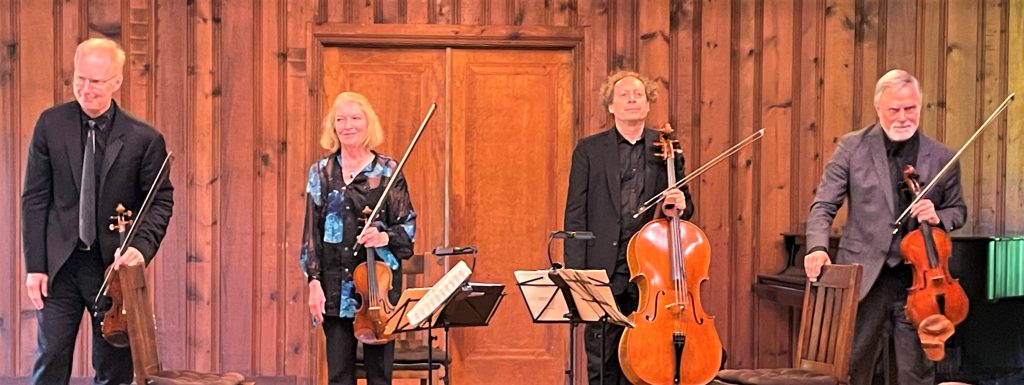
by Kevin T McEneaney
On a sunny hilltop day with nearly any humidity, the world-class American String Quartet, based at the Manhattan School of Music, opened with String Quarter in A Minor, Op. 29 (1824, nicknamed Rosamunde). This was the only occasion when a complete string quartet by Schubert was performed in public during Schubert’s lifetime and it was also the only quartet Schubert ever published. On the same program was Ludwig von Beethoven’s Septet, Op. 20. In the early days of Music Mountain this Schubert quartet remained a favorite; this was the nineteenth performance at Music Mountain.
The quartet opens with subtle melancholy in Allegro non troppo which appears to refer to Schubert’s early songs, especially in the second violin longingly played by Laurie Carney as a recollection of Schubert’s early songs, while the first violin, played with impressive force by Peter Winograd, dominated with arresting sound foregrounding the present. The cello and viola prod the second violin into more wandering digressions in the shadows. The following Andante takes up the principal tune in the 1823 drama of Rosamunde, Princess of Cyprus by Helmina von Chézy, which had been performed in December of 1823; Schubert composes variations on the sentimental tunes of the incidental music in the play while adding dramatic edge to the bland tunes, hence the nickname. Critics often say that here Schubert was influenced by Beethoven’s Seventh Symphony. The third movement Menuetto plumbs into cyclic themes to which Wolfram Koessel’s cello added engaging resonance while Daniel Avshalomev on viola discovered unexpected variations. There were moments when the whole quartet rose in such an arresting, unified explosion that one felt being on the edge of one’s seat. The concluding Allegro moderato began moderately, yet the finale uttered such a sound of uninhibited joy that the audience sprang to their feet with sustained applause.

Caroline Shaw (b. 1982), winner of the 2013 Pulitzer Prize for Music, remains one of this country’s most excellent and prolific classical composers. Peter humorously complained that it was patently unfair that she was also a superb violinist as well as singer. Blueprint comes from “aizuri-e,” a style of Japanese woodblock printing that primarily uses a blue ink, yet it is also related to the blueprints of a building. According to Shaw “This piece began its life as a harmonic reduction — a kind of floor plan — of Beethoven’s string quartet Op. 18 No. 6,” which she has performed many times. Elements of the work are rearranged into surprisingly post-modern segments that surf the sea of Beethoven’s notes producing an atomized structure of wonder, astonishment, and vigorous humor.
This quartet has had extensive contact with Vivian Fung (b. 1975). She noticed that Bela Bartok was the only classical composer to have written a quartet that was entirely in pizzicato. Daniel mentioned that they heard the first movement with approving excitement and then asked where the other three movements were. The American String Quartet worked with Vivian when she completed the quartet a few years later; she guided them in producing the pizzicato sound she wished to have. The audience was treated to the most authentic performance possible of Pizzicato, From String Quartet #1 (2001) which was, by turns, amusing, surprising, captivating, incredible, and amazing!

After the break, the program offered String Quartet in F Major, Op. 135 (1826). This quartet was not performed during Beethoven’s lifetime. While this work is full of spare contrapuntal writing, it also contains an astonishing variety of textures and varying volume of sound which the American String Quartet handled with smooth assurance. The euphonic interplay of instruments was mesmerizing. I have appreciated the recording of this magnificent masterpiece through hearing the Tokyo String Quartet, but here in live performance was the thrill of hearing this masterwork soar like I have never heard Beethoven performed before—I felt that this was an out-of-body experience—what Wordsworth called “unknown modes of being.” The word amazing is not good enough when it comes to Peter’s virtuous violin! The audience demanded a second bow and would have preferred a third.